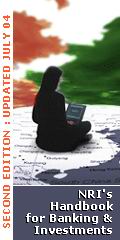|


|
Limited Direct Impact on Asia-Pacific Banks from Subprime Exposure
22 August 2007: Fitch Ratings has reviewed the exposures of most of its rated Asia-Pacific banks to US subprime-backed structured securities and found that direct exposures are low, generally amounting to just a few percent of the investing bank's equity capital.
"Losses on such investments will put a dent in annual earnings but do not pose a systemic risk as they are not a serious threat to the soundness of the banks we have surveyed," commented David Marshall, Managing Director and Head of Fitch's Financial Institutions Group in Asia- Pacific. "Banks in Japan and Australia also sponsor and provide liquidity facilities to conduits but in Fitch's view, the key issue here is the need for them to provide liquidity, rather than adding materially to their subprime exposures," he added. Fitch expects the banks to be able to meet these commitments given the modest size of the conduits relative to the banks' own balance sheets.
Fitch notes that subprime exposures are threatened by both mark to market valuation losses and real, economic losses. Mark to market losses will reflect the sudden drop in market values for these securities, to the extent these can be reliably identified; such charges could be increased or reversed depending on the ultimate level of economic losses on the underlying securities. The extent of these economic losses is not yet clear: 'AAA' and 'AA' rated securities are unlikely to incur losses but those at the lower end of the investment grade spectrum and below are likely to see significant losses.
Given the volatility in credit markets, Fitch acknowledges that there are risks to Asian banks beyond their subprime exposures. They may have to book accounting losses on marking to market other structured products, whose market values may be depressed by poor market sentiment and low liquidity. However, if they continue to hold the securities, these accounting losses should eventually be reversed and the banks should incur significant economic losses only if there is a material change in the default and loss rates on asset classes, other than on securities backed by US subprime mortgage exposures (in particular the more problematic 2006 vintage).
Australia: The banks have published few details but from our discussions with the Australian banks we rate, their potential exposure to the US subprime mortgage market through investments in structured credit instruments such as asset-backed securities (ABS) and collateralised debt obligations (CDOs), are limited, and any subprime element very small. Most of their holdings are of higher rated tranches ('AAA' and 'AA').
Similarly, their exposure through asset-backed commercial paper (ABCP) conduit programmes appears limited, although some banks do provide liquidity back-up facilities for these programmes. The larger banks have sponsored and/or provided liquidity back-up facilities to conduits and could be called up to provide liquidity. We understand that the banks are making preparations in case they are called on to meet these commitments.
While Fitch believes that exposure to the US subprime mortgage market will not produce significant losses for the Australian banks, market conditions for credit have tightened in recent weeks. Australian banks are typically reliant on wholesale funding for a large part of their total funding requirements. The cost of accessing the wholesale market has also increased. If prolonged, the current liquidity crunch could impact the ability of Australian banks to do business through higher funding costs and, potentially, result in difficulty refinancing debt as it matures, particularly commercial paper. The latter is likely to be more of an issue for the smaller institutions; however Fitch has not seen anything to indicate this has occurred substantially in the banking sector thus far and the underlying condition of banks is good, thanks to the buoyant Australian economy .
Japan: The larger banks have disclosed the following information:
* Sumitomo Mitsui Financial Group (SMFG) sold the bulk of its holdings exposed to products backed by US mortgages including subprime mortgages, earlier this year, realising a loss of several billion yen. It currently has about JPY100bn (<2% of equity) remaining, mostly in 'AAA' rated securities, but also including some junior tranches.
* Among Mitsubishi UFJ Financial Group's (MUFG) securitised products, JPY280bn is in investments with US subprime exposure (3% of equity). 97% is rated 'AAA' and the valuation loss at end-July was JPY5bn.
* Mizuho Financial Group has stated that it sold almost all of its US RMBS-related securities of JPY50bn it held at end-June, for a loss of JPY0.6bn.
* Aozora has disclosed that its CDO holdings include JPY21bn of subprime related (<3% of equity) and that it has booked losses of around JPY5bn to date mainly reflecting market value declines. Aozora states that its sizeable hedge fund investments are not significantly exposed to the US subprime problem and have continued to perform well.
* Shinsei has disclosed its total exposure to the US residential mortgage market of under USD500m (JPY60bn, 6% of equity); about half is in residential mortgage-backed securities (RMBS), of which the subprime component is "negligible" and half are rated 'AAA'.
* Sumitomo Trust has disclosed JPY14bn (1% of equity) of investments in ABS whose underlying assets may have a US subprime element but are rated 'AAA' to date. Chuo-Mitsui and Resona have stated they have no CDOs or ABS with US subprime exposure.
In the case of all these banks, any likely losses would be comfortably absorbed by a portion of the bank's annual earnings and none should see its solvency threatened from this factor alone, as the exposures are only a small fraction of the banks' equity. Fitch notes that there are other banking institutions in Japan with overseas investments that may include US mortgage-backed securities but as yet we do not have detailed information from all such institutions, which include regional banks, shinkin and agricultural co-operatives. Fitch will issue further comments as more data becomes available.
The large Japanese banks have sponsored and provided liquidity commitments to a number of conduits; to fulfill these commitments they may need to raise liquidity in yen and dollars, although these banks are unlikely to encounter difficulties raising the necessary liquidity, given the limited size of these commitments versus their balance sheets (up to 5%).
Among the securities firms, Nomura has disclosed end-June 2007 holdings of JPY266bn of RMBS, of which JPY71bn included subprime mortgages. This latter figure is about 8% of Nomura's equity. In the quarter to June 30th, Nomura posted a loss of JPY31bn which included the effects of selling and marking to market RMBS investments that had been a more substantial JPY658bn as of March 31st. Daiwa Securities has stated that it has no such exposures and Nikko Cordial that it has not incurred any losses.
>>> Next page for more comments on India & other countries
(This is press release of Fitch Ratings)
RELATED ARTICLES
Special section on Sub Prime ...Click here
Bank rating downgrades unnecessary on wide scale ...Click here
US Federal Reserve cuts discount lending rate ...Click here
Moody's on sub prime exposures of US banks ...Click here
S&P report on today's credit market risks ...Click here
CLICK FOR MORE FEATURES & STORIES
|
|


|





